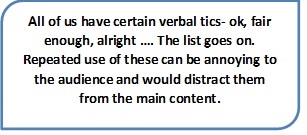Powerful Communication
First impression matters
As humans, snap judgments are part of the way we operate. It is inevitable and we all make first impressions- of people, of a product or of a house you want to buy. Once you walk into a room as the presenter for the session , the audience in the first few seconds have judged assessed and evaluated you. Most of the impression is there to stay!
So what should you do to create a great first impression? A holistic look at the various aspects that the audience is noticing about you will help you understand what you need to do . 
The first in the list is strong and confident posture. Nonverbal signals are noticed far more quickly than verbal signals. Keep your body erect when you walk into the room.
Don’t cross either arms or legs when standing in front of the audience as this conveys a closed approach. Leaning on the podium, or slouching, shows laziness and disrespect. No doubt you may feel nervous but put forth an air of confidence! Facial expressions show your emotions, so be careful. Keep a happy friendly smiling expression and smile genuinely! It might be good to do a few facial exercises( smile as wide as you can, open and close your mouth wide ) to release the tension just before you enter the room. It takes off the nervous and tense look away.
Appropriate clothing is essential and also signifies authority and professionalism. Analyze your audience and dress accordingly.
And surely watch your gestures – no rocking, no hands in pockets, and no nervous tics like rubbing your nose or pushing back your hair.
Engage with the audience through eye contact; maintain a comfortable distance from the audience. Decide where you want to place yourself. Avoid standing behind the podium as this creates a barrier between you and the audience.
With all of this in place, you will connect with your audience on a human level and they will have a positive impression that will make them want to listen to you.
Style and Tone

Each of us has over time evolved a certain style of communication. However, when presenting before an audience, there must be a certain amount of formality in speech. As discussed earlier, the best style of presentation to adopt is using visual cue cards, (have your support notes alongside) and speak freely without referring or reading prepared text. This will help to keep the tone conversational. In this manner, as long as you maintain the logical flow, you will feel free to add or deduct, make subtle changes than if you were reading a fully prepared text. Keep the syntax simple, and make relevant pauses for the audience to digest the gist of what you’re saying. 
Register, tone, and language are crucial elements of style. Register refers to the concept of using a particular type of language for particular purposes. A formal register would mean using correct grammar, no jargon or slang. To achieve an informal register, you could use colloquial language, and perhaps be informal with grammatical usage .
All of us have certain verbal tics- ok, fair enough, alright …. The list goes on. Repeated use of these can be annoying to the audience and would distract them from the main content.
When it comes to voice quality adding emphasis and tonal variation will bring variety into your speech. Tone in speech refers to the feeling you are conveying to the audience. Are you sounding condescending, do you sound knowledgeable? Are you conversational and engaging? Avoid monotony in your tone, sound enthusiastic and energetic.
Summary:
- Remember the first few seconds make the most impact.
- Keep your verbal cue cards with you when presenting.
Copyright (c) Infosys BPO Limited and/or its licensors, 2014, all rights reserved